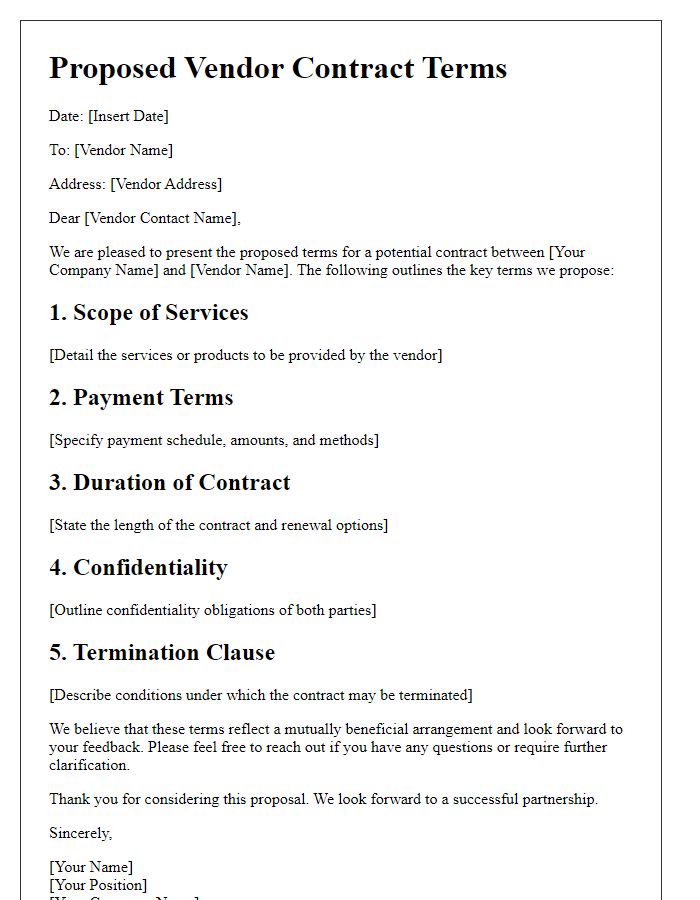Are you gearing up for vendor contract negotiations but unsure of where to start? Navigating these discussions can feel daunting, but a well-crafted letter can set the tone for a successful partnership. With the right approach, you can outline your needs, express your expectations, and foster a collaborative atmosphere. If you're ready to dive into the specifics of a compelling vendor contract negotiation letter template, keep reading for expert tips and examples!

Clear identification of parties involved
In a vendor contract negotiation, clear identification of the parties involved is crucial for establishing a solid foundation. The first party is the "Vendor," which refers to a business entity, such as Apex Supply Co., located in Chicago, Illinois, specializing in industrial-grade tools and equipment. The second party is the "Client," which can be represented by Global Manufacturing Group, a medium-sized company headquartered in New York, New York, that operates within the automotive industry. Complete legal names, addresses, and contact information for both parties ensure transparency and clarity in the agreement. This precise identification prevents ambiguity and guarantees that all terms apply to the correct entities during the negotiation process.
Detailed scope of work or services
The detailed scope of work for a vendor contract negotiation encompasses specific tasks, responsibilities, and deliverables that the vendor is expected to provide throughout the service duration. For example, a software development vendor may be required to implement a mobile application for iOS and Android platforms, ensuring compatibility with devices such as iPhone 12 (released in 2020) and Samsung Galaxy S21 (launched in 2021). Additionally, the vendor must conduct user testing sessions with at least 50 participants to gather feedback on functionality and ease of use. Timelines for project milestones should be established, with the initial prototype due within three months of contract signing. Furthermore, the scope should address the provision of ongoing technical support for a minimum of six months post-launch, inclusive of monthly performance assessment reports detailing app usage and any identified bugs. This comprehensive outline ensures clarity and accountability for both parties throughout the engagement.
Pricing terms and payment schedule
Pricing terms in vendor contracts typically outline the cost structure of goods or services being provided, specifying unit prices or total amounts and any applicable discounts. Payment schedules detail when payments are due, often including initial deposits, milestones, and final payments. Clarity in these sections helps prevent misunderstandings and ensures both parties are aligned. Commonly, net terms might be specified, such as "Net 30 days," indicating that payment is due within 30 days of invoice receipt. Additionally, late payment penalties can be included; these stipulate fees or interest rates that apply if payments are not made on time. For larger contracts, mechanisms for adjusting pricing based on inflation or changes in supply costs may also be part of the agreement to protect both the vendor and the buyer from unexpected financial burdens. Regular payment review dates enhance transparency and allow for adjustments in the ongoing relationship.
Performance metrics and delivery timelines
Performance metrics establish measurable outcomes for vendor deliverables, ensuring accountability and quality standards. Defined key performance indicators (KPIs) may include accuracy rates, customer satisfaction scores, and adherence to service level agreements (SLAs). Delivery timelines specify critical dates for product or service provision, emphasizing milestones within the supply chain or project lifecycle. For instance, a vendor might be required to deliver materials within 30 days from purchase order issuance, which aligns with project planning phases. Regular performance reviews, scheduled bi-monthly or quarterly, assess the vendor's adherence to these metrics and timelines, allowing for adjustments and improving collaboration over time. Overall, effective performance metrics and delivery timelines enhance operational efficiency and foster strong partnerships with external vendors.
Termination clauses and conditions
Termination clauses in vendor contracts serve to outline the conditions under which either party may terminate the agreement. Common conditions include breaches of contract, non-compliance with performance standards, or insolvency situations. Typically, most contracts stipulate a notice period, often ranging from 30 to 90 days, allowing for a graceful exit from the partnership. Furthermore, specific reasons for immediate termination may include failure to deliver goods or services as specified, violations of confidentiality, or legal infractions. Additionally, contracts may include details regarding the handling of unfinished projects and the return of materials. It is crucial for both parties to clearly define the processes for dispute resolution prior to termination, ensuring an equitable solution in situations of disagreement. Balancing the rights and responsibilities of both parties in termination clauses helps protect the interests of involved entities, while fostering long-term professional relationships.













Comments